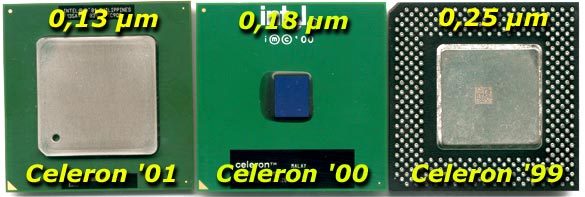Intel vs. AMD: Celeron 1300 vs. Duron 1200
Introduction
Intel Celeron 1300: Tualatin Core And 0.13 Micron
The launch of Intel's latest Celeron, which can now be had with a maximum clock speed of 1300 MHz, takes its battle with AMD to the next level. The Celeron 1300 is set to go head-to-head with the AMD Duron 1200, which is geared toward the same market segment. But the Celeron 1300, based on the Tualatin core, performs very sluggishly. The reason being that, with the front-side bus and memory clock limited to 100 MHz, it's hard to tweak the performance any more, no matter how high Intel may increase the clock speed. Or, to put it more bluntly, modern CPU meets obsolete platform. Plans to develop the latter further have long since been shelved by Intel.
The Intel Celeron 1300 is basically nothing more than a Pentium III with a 100 MHz ceiling imposed on its FSB clock speed. This measure was considered necessary by the chip monopoly's marketing gurus to ensure that there was enough distance between it and the Pentium 4.
Another feature that holds back the Celeron with the Tualatin core is the requirement that it be used in conjunction with conventional SDRAM, which puts yet another dent in the Celeron's performance. The Celeron would only be able to really show what it is capable of if DDR-SDRAM and an FSB clock speed of 133 MHz were available. However, our attempts to overclock the FSB clearly showed that anything above the 120 MHz limit spells stability trouble.
In all other respects, the Celeron uses state-of-the-art technology. The 0.13 micron fabrication behind it ensures that even a standard fan will keep the CPU icy, even when its voltage has been set to 1.50 V. There is one caveat, which we already mentioned in our article on the Celeron 1200. If you own an old board with an Intel 815EP chipset, you can forget using any new CPU with a Tualatin core.
Intel meets AMD: On the left, the Celeron 1300 with the Tualatin core. On the right, the Duron 1200 with the Morgan core.
The development of the Intel Celeron for the Socket 370: on the left, the latest CPU with the Tualatin core; in the middle, a Celeron with a Coppermine core; on the right, the first model in the PPGA format. This Celeron came out three years ago.
Get Tom's Hardware's best news and in-depth reviews, straight to your inbox.
Current page: Introduction
Next Page Detailed Comparison: Celeron 1300 Vs. Duron 1200-
disagree. tualatin celeron eats the duron, especially done right. clearly it comes out ahead in most tests, and that's without even mentioning the fact a tualatin celeron 1000a is the easiest overclock ever at 1330. also, the sis635 chipset could in fact marry this chip to DDR, which wasn't tested here.Reply
even without all that it still comes out ahead in many "every day" tests, and to just look at the wattage difference, the very slight extra duron oomph simply doesn't justify the fan noise. this line of celerons were the best deal in town when they came out. they are the cherries on top of the 686 cake.


